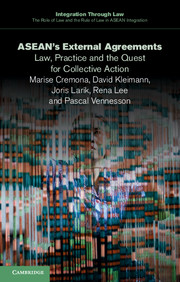Book contents
- Frontmatter
- Contents
- List of tables
- List of charts
- General editors' preface
- 1 Introduction
- 2 The legal and institutional framework for ASEAN external agreements: the centrality of ASEAN
- 3 An inventory and typology of ASEAN external instruments: overview and trends
- 4 ASEAN as a contracting party
- 5 Beyond market access? The anatomy of ASEAN's preferential trade agreements
- 6 A regional strategy: a typology of ASEAN partnership and co-operation agreements
- 7 Between great-power rivalries and supranationality: ASEAN external instruments and regional hedging strategies
- Executive summary
- Appendices
- Index
7 - Between great-power rivalries and supranationality: ASEAN external instruments and regional hedging strategies
Published online by Cambridge University Press: 05 May 2015
- Frontmatter
- Contents
- List of tables
- List of charts
- General editors' preface
- 1 Introduction
- 2 The legal and institutional framework for ASEAN external agreements: the centrality of ASEAN
- 3 An inventory and typology of ASEAN external instruments: overview and trends
- 4 ASEAN as a contracting party
- 5 Beyond market access? The anatomy of ASEAN's preferential trade agreements
- 6 A regional strategy: a typology of ASEAN partnership and co-operation agreements
- 7 Between great-power rivalries and supranationality: ASEAN external instruments and regional hedging strategies
- Executive summary
- Appendices
- Index
Summary
Introduction
In the previous chapters we presented and discussed the characteristics of the 175 ASEAN external instruments, including international agreements, memoranda of understanding, plans of action and declarations, covering the fields of economic, security, political and socio-cultural co-operation, put into place since the early 1990s and, particularly, between 2000 and 2012. Along the way, we uncovered four seemingly paradoxical characteristics of these external instruments taken as a whole. First, Southeast Asian states frequently use ‘ASEAN’ as a label or a frame in the context of external agreements, thereby promoting ASEAN identity and its ‘centrality’ in a number of regional initiatives. Yet ASEAN as a regional organisation is rarely a genuine protagonist in the sense of a legal party, especially when policy-makers perceive the issues as significant (diplomatically and/or economically) and the chosen instrument is legally binding. Second, while the legal potential in ASEAN external relations exists and was formally affirmedby the ASEAN Charter, with the notable exception of the economic instruments, the external instruments actually put to the task are predominantly non-legally binding. Third, the ASEAN Charter and ASEAN external instruments emphasise the centrality of ASEAN as an important vehicle to promote and stabilise the regional order preferred by the member states. Yet, substantially, ASEAN external instruments are ‘multidirectional’, promoting an open regionalism by no means confined to ASEAN itself which may undermine the very centrality of ASEAN. Fourth, half of ASEAN external instruments are economic in nature and are designed to offer economic benefits. Their immediate commercial benefits, however, are limited as a result of ASEAN collectivity and the plurilateral mode of contracting: the inclusiveness of these agreements decreases the lowest common denominator of commonly agreed commitments and discourages deeper individual commitments due to free-rider problems in the plurilateral negotiation setting.
- Type
- Chapter
- Information
- ASEAN's External AgreementsLaw, Practice and the Quest for Collective Action, pp. 257 - 296Publisher: Cambridge University PressPrint publication year: 2015

